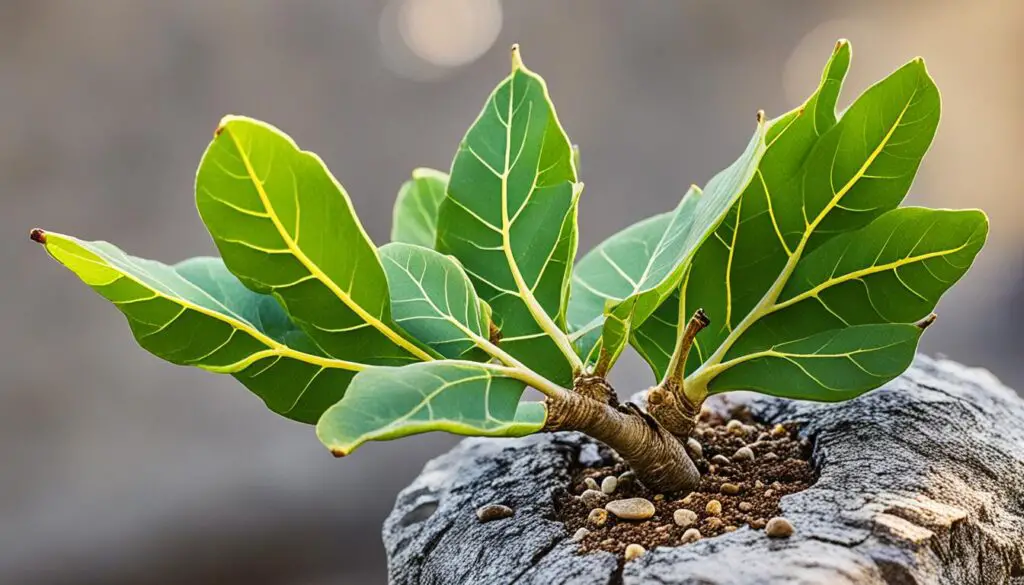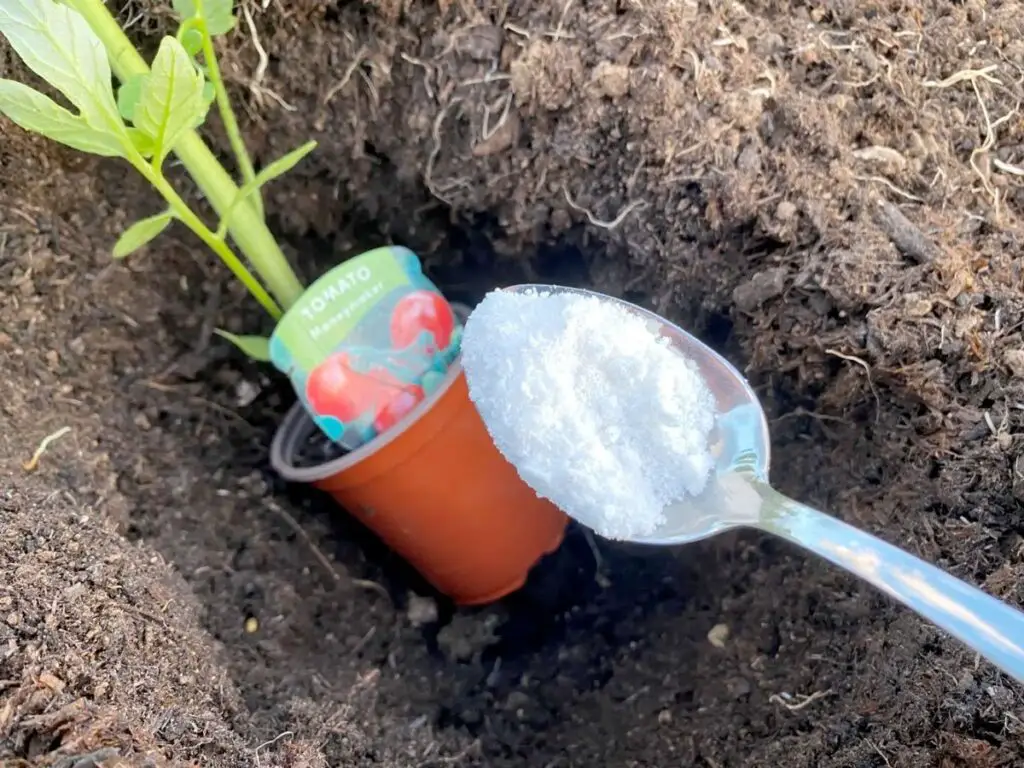Want to grow your own fig trees and enjoy fresh, juicy fruits right in your backyard? This guide is for you! We’ll show you how to propagate fig trees from cuttings.
It doesn’t matter if you’re new to gardening or have years of experience. You’ll learn the key steps to root and care for your fig tree.
From picking the right cutting to moving the rooted cutting, we’ve got you covered. This article will give you the skills and confidence to grow fig trees from cuttings and enjoy the taste of homegrown figs.

Key Takeaways
- Discover the benefits of propagating fig trees from cuttings
- Learn how to select the best cutting for successful propagation
- Understand the step-by-step process of preparing and rooting fig tree cuttings
- Explore the ideal potting mix and container for your fig tree cuttings
- Gain insights into caring for your fig tree cuttings to ensure healthy growth
What is Propagation and Why Propagate Fig Trees?
The art of plant propagation is making new plants from ones that already exist. This can be done through cuttings, seeds, or division.
For those who love fig trees, it’s a great way to grow your own at home without spending a lot.
Understanding the Benefits of Plant Propagation
Propagating plants has many perks. It lets you grow genetically identical plants, which can start producing fruit faster than from seeds. Plus, it saves money by not needing to buy new plants every year.
The Advantages of Propagating Fig Trees
- Create a larger, thriving fig tree population in your garden or orchard.
- Ensure that the new fig trees possess the same desirable traits as the parent plant, such as fruit quality and hardiness.
- Potentially see faster fruit production compared to growing fig trees from seed.
- Reduce the overall cost of expanding your fig tree collection.
Learning about the perks of plant propagation and fig trees can help you decide to start your own propagation journey.
Selecting the Right Cutting for Propagation
Choosing the right cutting is key to growing fig trees. The type of cutting and when you take it greatly affects success.
This choice can make a big difference in how well your cuttings root and grow.
Identifying the Best Time for Taking Cuttings
The best time for taking fig tree cuttings is in the spring or early summer. This is when the plant is most active. It’s when the plant’s metabolism is high, and cuttings are more likely to root well.
Don’t take cuttings in the winter when the plant is dormant. The plant is trying to survive the cold then, not grow new shoots.
Look for healthy, disease-free shoots from the current season’s growth. These should be 6-8 inches long with several nodes. Don’t use cuttings from the plant’s base as they might rot easily.
| Characteristic | Ideal Fig Tree Cutting |
|---|---|
| Cutting Type | Terminal or lateral cutting |
| Length | 6-8 inches |
| Nodes | Several nodes |
| Timing | Spring or early summer |
By following these tips and choosing the right cuttings at the best time, you’ll be on your way to growing your own fig trees.
Preparing the Cutting for Propagation
Propagating fig trees from cuttings is a rewarding way to grow more plants. It’s also a cost-effective method.
Before starting, you need to prepare the cutting right. This step is key to growing new fig tree plants successfully.
Tools and Materials Needed for Cutting Preparation
First, gather the right tools and materials for preparing fig tree cuttings. You’ll need:
- Clean, sharp pruning shears or scissors
- Rooting hormone powder or gel
- Clean, sterile containers or pots
- Well-draining potting mix or soil
Step-by-Step Instructions for Preparing the Cutting
Here are the steps to prepare your fig tree cutting for propagation:
- Select a healthy, young stem or branch from the fig tree, typically 6-12 inches long.
- Using your clean pruning shears, make a clean, straight cut just below a leaf node (where the leaf meets the stem).
- Remove any leaves or foliage from the lower half of the cutting, leaving the top leaves intact.
- Dip the cut end of the cutting into a rooting hormone powder or gel, following the manufacturer’s instructions.
- Plant the prepared cutting in a clean, well-draining container filled with a suitable potting mix or soil.
By following these steps, you’ll have your fig tree cutting ready for the rooting phase.
Propagate Fig Trees from Cuttings: The Rooting Process
Propagating fig trees from cuttings is a rewarding process. It can lead to healthy, thriving plants. The rooting process is key to success in fig tree propagation.
By knowing what affects rooting, you can increase your chances of growing strong fig tree cuttings.
Several factors influence the rooting process, like temperature, humidity, and light exposure. It’s important to keep the right growing conditions for strong roots.
Choosing the right soil, like a well-draining potting mix, is also crucial for rooting.
- Place the cutting in a warm, humid spot with plenty of indirect sunlight. This encourages root growth and reduces stress.
- Check the soil moisture often and keep it moist but not too wet. Too much water can cause rot and slow down rooting.
- Think about using a rooting hormone or growth stimulant to help the cutting grow strong roots.
Watch the cutting for signs of new growth and roots as it roots. With patience and proper care, your fig tree cuttings can grow into thriving plants. This will lead to beautiful fig trees in your garden.

“Propagating fig trees from cuttings is a rewarding way to expand your orchard and share the joy of these delicious fruits with others.”
Choosing the Right Potting Mix and Container
Choosing the right potting mix and container is key when growing fig tree cuttings. The right mix and container help your cuttings grow strong and healthy roots. This is crucial for their success.
Essential Characteristics of a Good Potting Mix
A top-notch potting mix for fig tree cuttings should have several important traits:
- Excellent drainage: It must drain well to prevent waterlogging and root rot, which harm the cutting’s health.
- Nutrient-rich: It should have essential nutrients like nitrogen, phosphorus, and potassium to help the cutting grow and develop.
- Balanced pH: The mix’s pH should be slightly acidic, between 6.0 and 6.5, as fig trees do well in these conditions.
When picking a potting mix for your fig tree cuttings, aim for a mix that has these key traits. This will give your cuttings the best growing conditions.
Best Containers for Propagating Fig Trees
The container you pick should drain well and be the right size. Choose one that’s just a bit bigger than the root system.
This encourages healthy root growth without waterlogging. Good options include small pots, seed trays, or propagation domes. These provide the support and airflow your cuttings need.
| Container Type | Advantages | Disadvantages |
|---|---|---|
| Small Pots | Excellent drainage, easy to manage, can be moved easily | Limited root space, may require more frequent watering |
| Seed Trays | Allows for multiple cuttings in one container, provides good airflow | May require more attention to individual cuttings, can be more challenging to transplant |
| Propagation Domes | Maintains high humidity, promotes root growth, protects cuttings | Require more specialized setup, can be more expensive |
By picking the right potting mix and container, you set your fig tree cuttings up for success. They’ll have the best start on their way to becoming strong, healthy plants.
Planting and Caring for the Cutting
Now that you’ve prepared your fig tree cutting, it’s time to plant and care for it. Proper planting and care are key for your cutting to grow well.
Proper Planting Techniques for Fig Tree Cuttings
When planting, gently place the cutting in the potting mix. Make sure not to hurt the stem. Plant it 4-6 inches deep, with 1-2 inches above the soil.
Leave about 12-18 inches between cuttings for growth and air.
Watering, Lighting, and Temperature Requirements
Watering your fig tree cutting is very important. Keep the soil moist but don’t overdo it. Water every 2-3 days, depending on the soil and conditions.
Fig tree cuttings need bright, indirect sunlight. Give your cutting 6 hours of sunlight daily. Use a sunny window or artificial lights. Keep the temperature warm, around 70-85°F (21-29°C), for best growth.
Follow these tips to grow a healthy fig tree from your cutting.
| Planting Depth | Spacing | Watering Frequency | Lighting | Temperature |
|---|---|---|---|---|
| 4-6 inches | 12-18 inches | Every 2-3 days | Bright, indirect sunlight (6+ hours) | 70-85°F (21-29°C) |

“Patience and attentive care are the keys to successfully propagating fig trees from cuttings.”
Troubleshooting Common Issues with Fig Tree Propagation
Fig tree propagation from cuttings can be tricky, but you can fix common problems. We’ll cover issues like cuttings not rooting, leaves wilting, and fungal growth. These solutions will help your fig tree cuttings succeed.
Cuttings Failing to Root
If your fig tree cuttings won’t root, there are a few reasons. Make sure you use the right cutting material and choose healthy, mature wood.
Check the soil’s moisture and adjust it if needed. Using a rooting hormone can help, and ensure the cutting gets enough light and warmth.
Wilting Leaves
Wilting leaves mean your cutting might be stressed or not cared for right. Make sure it gets enough water but not too much, which can cause root rot. Use a humidity dome or mist the leaves to keep them moist. Also, make sure it’s in a spot with good sunlight and not too cold or windy.
Fungal Growth
Fungal infections are common in fig tree propagation. Watch for mold or discoloration and deal with it fast.
Clean your tools and work area, and use a fungicide in the soil. Increase air flow and lower humidity to stop more fungal growth.
| Common Problem | Possible Causes | Troubleshooting Tips |
|---|---|---|
| Cuttings Failing to Root |
|
|
| Wilting Leaves |
|
|
| Fungal Growth |
|
|
By fixing these common problems, you can boost your chances of growing fig trees from cuttings. Remember, it might take time and effort, but the joy of having your own fig trees is worth it.
When and How to Transplant Rooted Cuttings
Once your fig tree cutting has taken root, it’s time to move it to a bigger container or into the ground.
Knowing when and how to do this ensures your fig tree grows well. It’s important to watch for certain signs and follow the right steps.
Signs that Your Cutting is Ready for Transplanting
Look for strong roots coming from the cutting’s base to know it’s ready. This usually happens in 4-6 weeks, based on the environment. Gently pulling on the cutting will show if the roots are strong.
Also, watch for new leaves and active growth. This means the plant is ready to focus on growing above ground too.
FAQ
What is plant propagation and why is it beneficial to propagate fig trees?
Plant propagation means making new plants from ones that already exist, like through cuttings, seeds, or division. Propagating fig trees from cuttings is a great way to grow your own trees at home. It saves money and can lead to fruiting faster than seed-grown trees.
What is the best time of year to take fig tree cuttings for propagation?
The best time for taking fig tree cuttings is in the spring or early summer. This is when the tree is most active. It gives the cuttings the best chance to root and grow well.
What tools and materials are needed to prepare fig tree cuttings for propagation?
You’ll need clean, sharp pruning shears, rooting hormone powder or gel, a well-draining potting mix, and a good container for the cuttings. Having these tools ready will help prepare the cutting for rooting.
How do I properly plant and care for a fig tree cutting during the rooting process?
Plant the cutting in a well-draining potting mix and a container with good drainage. Make sure it’s planted at the right depth and water it well, but don’t overdo it. Give it bright, indirect light and keep the temperature and humidity right to help it root.
What are some common issues that can arise when propagating fig trees from cuttings, and how can I troubleshoot them?
Issues like cuttings not rooting, leaves wilting, or fungal growth can happen. To fix these, check the soil moisture, adjust the light or temperature, or treat fungal infections. Watching the cutting closely and making changes as needed can help ensure success.
How do I know when my fig tree cutting is ready to be transplanted, and what is the best way to transplant it?
Look for signs like a strong root system, new growth, and the cutting being well-rooted. When transplanting, carefully move the cutting to a bigger container or directly into the ground. Water it well and keep an eye on it as it adjusts.



